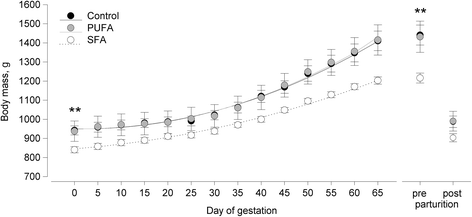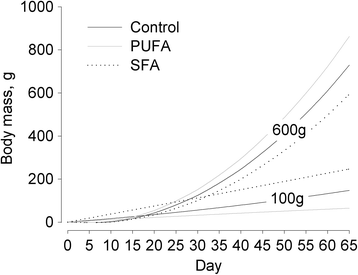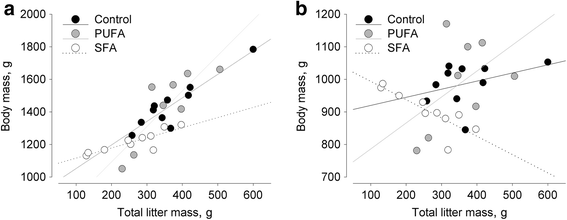Reproductive performance and gestational effort in relation to dietary fatty acids in guinea pigs
- PMID: 28373905
- PMCID: PMC5376286
- DOI: 10.1186/s40104-017-0158-4
Reproductive performance and gestational effort in relation to dietary fatty acids in guinea pigs
Abstract
Background: Dietary saturated (SFAs) and polyunsaturated (PUFAs) fatty acids can highly affect reproductive functions by providing additional energy, modulating the biochemical properties of tissues, and hormone secretions. In precocial mammals such as domestic guinea pigs the offspring is born highly developed. Gestation might be the most critical reproductive period in this species and dietary fatty acids may profoundly influence the gestational effort. We therefore determined the hormonal status at conception, the reproductive success, and body mass changes during gestation in guinea pigs maintained on diets high in PUFAs or SFAs, or a control diet.
Results: The diets significantly affected the females' plasma fatty acid status at conception, while cortisol and estrogen levels did not differ among groups. SFA females exhibited a significantly lower body mass and litter size, while the individual birth mass of pups did not differ among groups and a general higher pup mortality rate in larger litters was diminished by PUFAs and SFAs. The gestational effort, determined by a mother's body mass gain during gestation, increased with total litter mass, whereas this increase was lowest in SFA and highest in PUFA individuals. The mother's body mass after parturition did not differ among groups and was positively affected by the total litter mass in PUFA females.
Conclusions: While SFAs reduce the litter size, but also the gestational effort as a consequence, PUFA supplementation may contribute to an adjustment of energy accumulations to the total litter mass, which may both favor a mother's body condition at parturition and perhaps increase the offspring survival at birth.
Keywords: Body mass; Female reproduction; Gestation; Litter size; Polyunsaturated fatty acid; Saturated fatty acid; Total litter mass.
Figures



Similar articles
-
Sex-specific effects of dietary fatty acids on saliva cortisol and social behavior in guinea pigs under different social environmental conditions.Biol Sex Differ. 2016 Sep 22;7:51. doi: 10.1186/s13293-016-0107-5. eCollection 2016. Biol Sex Differ. 2016. PMID: 27688870 Free PMC article.
-
NTP technical report on the toxicity studies of Dibutyl Phthalate (CAS No. 84-74-2) Administered in Feed to F344/N Rats and B6C3F1 Mice.Toxic Rep Ser. 1995 Apr;30:1-G5. Toxic Rep Ser. 1995. PMID: 12209194
-
Effects of dietary fatty acids on the social life of male Guinea pigs from adolescence to adulthood.Horm Behav. 2020 Aug;124:104784. doi: 10.1016/j.yhbeh.2020.104784. Epub 2020 Jun 9. Horm Behav. 2020. PMID: 32504693
-
Does sow reproduction and piglet performance benefit from the addition of n-3 polyunsaturated fatty acids to the maternal diet?Vet J. 2013 Sep;197(3):560-9. doi: 10.1016/j.tvjl.2013.03.051. Epub 2013 May 15. Vet J. 2013. PMID: 23683532 Review.
-
The role of dietary fats for preventing cardiovascular disease. A review.Rocz Panstw Zakl Hig. 2013;64(4):263-9. Rocz Panstw Zakl Hig. 2013. PMID: 24693710 Review.
Cited by
-
Dietary fatty acids sex-specifically modulate guinea pig postnatal development via cortisol concentrations.Sci Rep. 2018 Jan 11;8(1):471. doi: 10.1038/s41598-017-18978-4. Sci Rep. 2018. PMID: 29323260 Free PMC article.
-
Short-term storage of semen samples in acidic extender increases the proportion of females in pigs.BMC Vet Res. 2021 Nov 26;17(1):362. doi: 10.1186/s12917-021-03078-3. BMC Vet Res. 2021. PMID: 34836535 Free PMC article.
-
Implications of Nutritional Management on Fatty Acid Profiles of Southern White Rhinoceroses (Ceratotherium simum simum) Housed at Two Zoological Institutions.Animals (Basel). 2021 Oct 27;11(11):3063. doi: 10.3390/ani11113063. Animals (Basel). 2021. PMID: 34827795 Free PMC article.
-
Maternal effects on reproduction in the precocial European hare (Lepus europaeus).PLoS One. 2021 Feb 17;16(2):e0247174. doi: 10.1371/journal.pone.0247174. eCollection 2021. PLoS One. 2021. PMID: 33596263 Free PMC article.
References
-
- Funston RN. Fat supplementation and reproduction in beef females. J Anim Sci. 2004;82(E-Suppl):E154–61. - PubMed
LinkOut - more resources
Full Text Sources
Other Literature Sources

